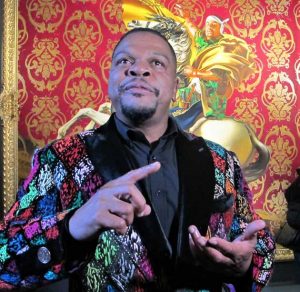Obama’s Portraitist Challenges Napoleon’s Painter
 12 Oktober 2019
12 Oktober 2019

Artist Kehinde Wiley discusses his work. Credit: A. D. McKenzie/IPS
By A. D. McKenzie
PARIS, Oct 11 2019 (IPS)
Fresh from unveiling a huge statue of a black man on horseback in New York’s Times Square, renowned African American artist Kehinde Wiley flew to France this week to “meet” 18th-century French painter Jacques-Louis David.
Wiley – most known for painting the portrait of US President Barack Obama in 2017 – is now “sharing a room” with David, who lived from 1748 to 1825 and was a painter and supporter of French military leader Napoleon Bonaparte.
In an exhibition titled “Wiley Meets David”, the American artist’s massive and colourful 2005 painting Napoleon Leading the Army over the Alps can for the first time be viewed opposite David’s 1800 depiction Bonaparte Crossing the Great St. Bernard Pass (Le Premier Consul franchissant le col du Grand-Saint-Bernard), in a show that runs until Jan. 6, 2020.
“There’s lots of chest beating going on … that’s why when you look closely at my painting, you’ll see sperm cells swimming across the surface,” said Wiley at the Oct. 9 opening of the exhibition. “This is masculinity boiled down to its most essential component. All of this stuff, warfare, is about egos, about nationhood, about the formation of society.”
The two works of powerful-looking men on horseback are presented “in dialogue” at the imposing Château de Malmaison, just outside Paris. This is the former residence of French Empress Joséphine, which she shared with Bonaparte before they divorced in 1809.
Wiley’s painting comprises a reinterpretation of David’s portrait, and it is the first in his series “Rumors of War”, where African American subjects replace the historically mighty in a questioning of warfare and inequality. Here, a model named Williams is on horseback, in the same pose as David’s Napoleon, but wearing contemporary urban gear and a golden cloak. In contrast, David’s depiction was a “symbol of the glory of Bonaparte” when it was produced in 1800, according to the show’s curators.
Wiley stressed that his work was meant to make people of African descent visible in ways that they haven’t been in the history of art. But he added that despite the aura of power in his painting, he was also portraying “fragility”, even amidst certain social advances.

Wiley arrives at the Château de Malmaison with associates. Credit: A. D. McKenzie
“I want to caution us against a facile acceptance,” Wiley said. “These steps that we’re moving forward with, I prize greatly, but I also recognize their fragility. As powerful as that young man looks on that horse, it’s not his power that I’m concerned about, but rather his fragile position within that culture … that relegates artists like myself to even need to make utterances like the ones that I’ve done.”
Before being brought to France, Wiley’s painting had been exhibited for years at the Brooklyn Museum of Art, and the current show is a joint project between this museum and the Château de Malmaison.
After the exhibition in France, both paintings will be on display in Brooklyn, from Jan. 24 to May 10, 2020. David’s work is therefore returning to the United States, where it had spent time in New Jersey in the 1800s as part of the property of Napoleon’s brother Joseph.
“The partnership with the Brooklyn Museum will provide an opportunity to shed light on the current practices of North American museums with regard to groups of artists who have been overlooked in history and the history of art, and their links to audience development,” said Emmanuel Delbouis, a co-curator of the exhibition.
For Wiley, 42 years old, it’s high time for a change in the narrative regarding the contributions of people who have traditionally been excluded from mainstream stories. He said it was not a “trend” or a “movement” that so many artists of African descent are now focusing on historical issues affecting people of colour.
“We have been able and capable of contributing to the larger conversation globally, and now these conversations are happening,” he said during the exhibition’s press opening. “I think perhaps the culture is evolving. So, it’s not a trend … it’s simply another human voice being paid attention to.”
He said his painting was a criticism of colonialism and a challenge to its legacy, but that it was also an “embrace” of French art and David’s talent.
Wiley, who rose to fame with the portrait of Obama, has seen his artistic impact grow, both in the United States and internationally. He has held several exhibitions in France, and before the opening of this latest show, the unveiling of his 27-foot-high statue in Times Square, on Sept. 27, garnered global attention.
That work, his first public sculpture, will be on view at the famed square for several weeks before being permanently installed at the entrance to the Virginia Museum of Fine Arts, in Richmond, Virginia. It is being shown at the same time as the painting in France, sparking dialogue on both sides of the Atlantic about history and who gets to be celebrated in public monuments.
“We’re standing on the leading edge of story-telling, arguably on the leading edge of propaganda,” Wiley said in France. “Art has for centuries been at the service of churches, of state, of powerful men. And now artists have the ability to take that language and do what they will with it.
“So what am I doing? I’m engaging that language in a way that says ‘yes’ to certain things and ‘no’ to others,” he added. “The culture evolves, but we’re stuck here together, and we have to figure out how we’re gonna evolve together.”
This article is published in an arrangement with Southern World Arts News. Follow on Twitter: @mckenzie_ale
The post Obama’s Portraitist Challenges Napoleon’s Painter appeared first on Inter Press Service.
